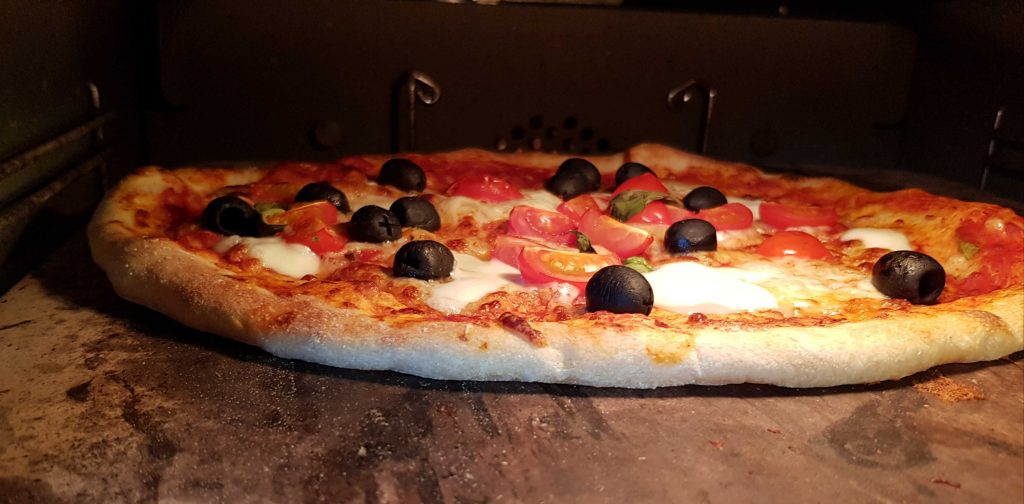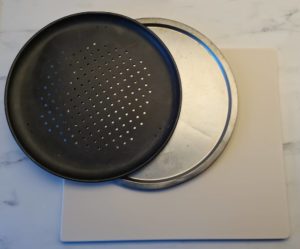I’ve tried a lot of different pizza stones, but the result is always the same. A thick pizza stone will make a better pizza than a thin pizza stone. But why does a thick pizza stone make better pizza? Keep reading to find out.
Is a Thick Pizza Stone Better?
Most budget pizza stones are around 0.4 – 0.5 inches (1 – 1.3 cm). When I’m talking about “thick pizza stones”, I’m referring to pizza stones that are thicker than 1/2 inch (1.3 cm).
A thick pizza stone is better than a thin stone, because it bakes pizza better, due to its conductive properties. It’s also more durable and will last you much longer. A thick pizza stone is however heavier, and is harder to handle, and also costs a bit more than a thin stone, but because it’s more durable, it’s still worth it in my opinion.
It Bakes Pizza Better
The main benefit of a thicker pizza stone is that it bakes better pizza. But why does a thicker pizza stone bake better pizza?
Our Goal: Neapolitan Pizza At Home
Before we talk about why it makes better pizza, we need to define what better pizza is. There are many ways to use a pizza stone, and you can make many types of pizza on one. But when I’m baking pizza on my pizza stone I’m mainly baking Neapolitan-styøe pizza, and I’m using the stone to try to get a result as close as possible to a wood-fired
In a Neapolitan
The goal is therefore to bake the pizza as fast as possible and get a slightly brown, crispy pizza crust.

Why a Thick Pizza Stone Bakes Better Pizza
A thick pizza stone retains heat better than a thin pizza stone. It also has better heat distribution. This means that the pizza gets crispier, and more evenly baked than on a thin pizza stone.
It Will Last Longer
Another benefit of a thicker pizza stone is that it’s sturdier. Pizza stones tend to crack. I’ve had a bunch of thin, cheap pizza stones that had to be replaced because they cracked. Pizza stones can crack for a variety of different reasons, but the most common is temperature (thermal) chock. This can happen when you put a cold pizza stone in a hot oven or place a cold pizza on a hot pizza stone. A thick pizza stone is stronger, will not crack as easily, and will last you longer than a thin pizza stone.
If you want to know more about why pizza stones crack, and how to prevent it, click here.
It Is Heavier and Harder to Handle
A disadvantage of thicker pizza stones is that they are heavier. They typically weigh 10-25 pounds (4.5-11 kg), which is twice the weight range of thin pizza stones.
It Cost More
Another thing worth mentioning is that a thick pizza stone tends to be more expensive than a thin pizza stone. They typically range from 30 to 100 dollars, depending on the shape, size, and how thick they are.
How Thick Should a Pizza Stone Be?
The short answer is as thick as possible. The thicker the pizza stone is, the more heat it’s going to retain, and the better the heat distribution will be.
Typically, a thick pizza stone is 1/2 to 1 inch thick. You can get even thicker pizza stones in specialty stores, but most kitchen stores will not carry anything thicker than 1 inch.
I recommend going for a 3/4 or 1-inch pizza stone for most people, since these make great pizza, and are fairly easy to find, but if you can get your hands on anything thicker, e.g. 2 inches, that’s even better!
How to Use a Thick Pizza Stone
Using a thicker stone is not very different from using a thin stone. The main difference is that it takes longer to pre-heat a thick pizza stone. I recommend pre-heating the pizza stone for at least 1 hour. If you want to know more about pre-heating pizza stones, check out this article.
- Place the pizza stone in a cold oven
- Turn on the oven and let it preheat for at least 1 hour
- Transfer the pizza onto the pizza stone using a
pizza peel , and bake it directly on the pizza stone. - Let it bake for 5-6 minutes until the pizza crust is nice and crispy, and the cheese is melted
- Remove the pizza from the oven and get ready to enjoy!
What Is the Best Thick Pizza Stone
The most important factor when you’re selecting a thick pizza stone, is obviously how thick it is. As mentioned above, I recommend going for a 3/4 to 1-inch (or more) thick stone. Another important thing to consider is the material it’s made from. You want to get a solid, durable stone, that’s not going to break.
Pizza stones come in different shapes and sizes, but this is all about your own preferences. Here are two of my favorite pizza stones; one square-shaped and one round stone.
The Best Squared Pizza Stone
The overall best widely available pizza thick pizza stone, in my opinion, is the California Pizza Stones Industrial Pizza Stone (affiliate link). This is a solid 1-inch thick pizza stone made in the US, that makes awesome pizza!
The pizza stone is made from unglazed ceramic. Personally, I’ve found that unglazed pizza stones bake better pizza. The reason is that they absorb more moisture during baking, resulting in a crispier pizza crust. It’s a solid stone, that also comes with a “100% guarantee against thermal shock and cracking during cooking or baking”, and they will replace the stone if it cracks. Meaning that it’s extra durable, and resistant against cracking from huge temperature differences (that has happened to me many times with other pizza stones…). The reason it’s more durable than most pizza stones is that it’s made from a Mullite composition, that expends less than most ceramic materials. This makes it perfect for pizza baking.
The pizza stone comes in two different sizes: 16×16 inches (affiliate link) and 18×18 inches (affiliate link). For most people, I would recommend the 16×16 inch version, since this will be large enough for most pizza baking, it’s also lighter than the 18×18 version. But it’s always nice with some extra baking space.
The reason this is my favorite pizza stone is that the thickness makes the perfect pizza. I also personally prefer square or rectangular stones, because it’s easier to place in the oven and gives me more options. I can bake square pizzas, and with a larger stone, I can even bake two pizzas, or calzones, side by side. The main drawback of this stone is the weight, the 18×18 inch version comes in at 24 pounds (11kg)! It’s also not the cheapest stone on the market. But overall, it’s an awesome pizza stone, that makes the perfect pizza!
The Best Round Pizza Stone
In the round pizza stone category, my top pick is the Culinary Couture Pizza stone (affiliate link). This is a 15-inch round pizza stone, that’s 3/4 inches thick. A durable and solid, pizza stone that will bake perfect pizza.
The Culinary Couture Pizza stone is made from cordierite, which is a very crack-resistant material. That combined with the thickness of the stone makes it very durable, and it’s unlikely to crack! This stone also comes with an unglazed surface, that absorbs moisture better and bakes crispy, nice pizza.
Even though my favorite is the California Pizza Stones Industrial Pizza Stone, the Culinary Couture Pizza Stone has some benefits. Firstly, it’s much lighter, and easier to handle, at only 9 pounds (4 kg). Secondly, it’s much cheaper, at roughly half the price. So if you’re looking for a thick pizza stone on a budget, this is the stone for you!
Related
- Is Your Pizza Dough Too Dry? Here is How to fix it! - June 10, 2024
- The Ultimate Guide to the Pizza Dough Windowpane Test - June 8, 2024
- The Ultimate Guide to Autolyse Pizza Dough - June 7, 2024




